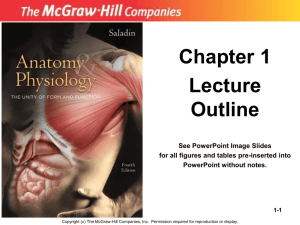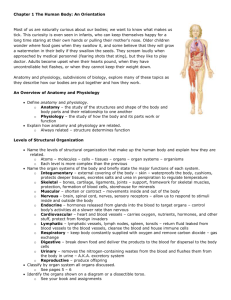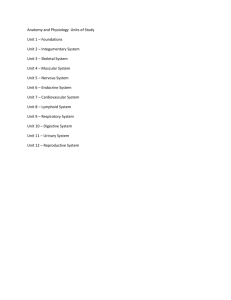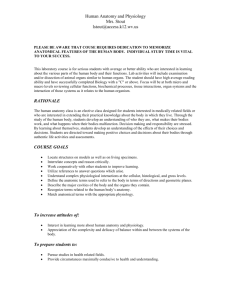Chapter 1
advertisement
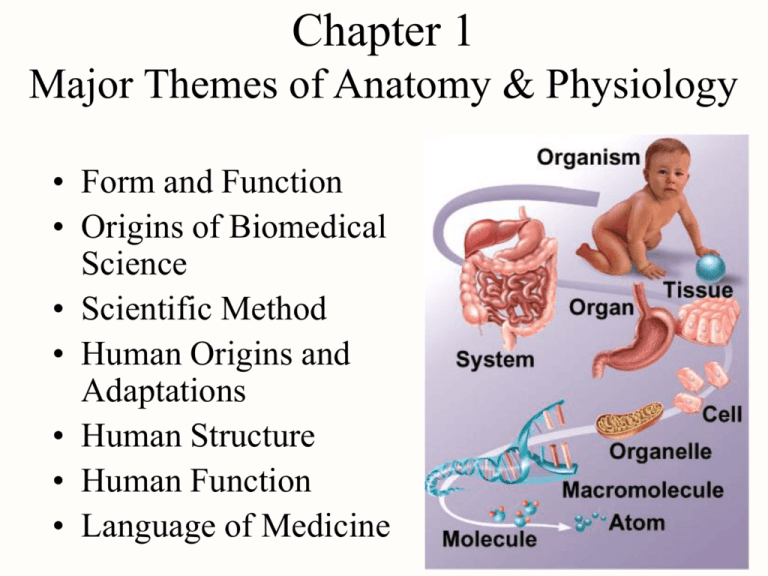
Chapter 1 Major Themes of Anatomy & Physiology • Form and Function • Origins of Biomedical Science • Scientific Method • Human Origins and Adaptations • Human Structure • Human Function • Language of Medicine Anatomy - The Study of Form • Observation of surface structure • Cadaver dissection is cutting & separation of organs to study their relationships • Comparative anatomy is the study of more than one species to analyze evolutionary trends • Physical examination – palpation, auscultation, percussion • Gross anatomy is what is visible with naked eye • Histology is examination of cells with microscope Early Anatomical Drawings Physiology - The Study of Function • Study of bodily functions by use of methods of experimental science • Comparative physiology involves the study of different species • Basis for the development of new drugs and medical procedures Beginnings of Medicine • Physicians in Mesopotamia & Egypt 3000 years ago used herbal drugs, salts & physical therapy • Greek physician Hippocrates established a code of ethics & urged physicians to seek causes of disease • Aristotle called causes for disease physiologi & said that complex structures are built from simpler parts • Galen, physician to the Roman gladiators, saw science as a method of discovery – did animal dissections since use of cadavers banned – wrote book advising followers to trust their own observation Birth of Modern Medicine • Little advancement during the Middle ages since medicine was taught as dogma with no new ideas • Avicenna from Muslim world supported free inquiry over authority – wrote The Canon of Medicine, used in medical schools until 16th century • • • • Vesalius published accurate gross anatomy atlas (1543) Harvey realized blood flow out from heart & back in 1628 Leeuwenhoek invented microscope to look at fabrics (1632-1723) Hooke (1665) and Zeiss (1860) developed & improved compound microscope (described plant cell walls in 1665) • Schleiden & Schwann thought that all organisms were composed of cells -- cell theory of 1839 • Clinical practice was in dismal state – bleeding patients to remove toxins, operate with dirty hands, no anesthesia for amputations Early Microscopes Living in a Revolution • Pioneers in 19th & 20th centuries – established scientific way of thinking – replaced superstition with natural laws – momentous discoveries • germ theory of disease • heredity & structure of DNA • Now at threshold of modern biomedical science – technology enhanced diagnostic ability & life-support strategies – genetic revolution --library of the molecular structure of every human gene is finished • Gene therapy being used to treat disease Scientific Method • Bacon (1561-1626) and Descartes (1596-1650) – were not scientists but did invent new habits of scientific thought • scientific method as habits of disciplined creativity, careful observations, logical thinking & analysis of observations • way of seeking trends & drawing generalizations • Convinced governments of England & France to form academies of science that still exist today • Scientific way of thinking based on assumptions & methods that are reliable, objective & testable Inductive Method • First described by philosopher Francis Bacon • Making observations until capable of drawing generalizations and making predictions – anatomy is a product of inductive method • Proof in science can not go past “proved beyond reasonable doubt” – reliable methods of observation – tested and confirmed repeatedly – not falsified by any credible observation • In science, all truth is tentative Hypothetico-Deductive Method • Physiological knowledge gained by this method • Ask a question and formulate a hypothesis -- an educated possible answer • Good hypothesis – consistent with what is already known – capable of being tested and falsified with certain evidence • If nothing could prove it wrong, it is not a scientific belief • Hypotheses are written as If-Then predictions – modified and rewritten after testing Experimental Design • Sufficient sample size to prevent chance event • Control group and treatment group receive the same treatment except for the variable being tested • Prevention of psychosomatic effects – use of placebo in control group • Experimenter bias – prevented with double-blind study • Statistical testing to be sure the difference between groups was not random, but was due to variable being tested Peer Review • Critical evaluation by other experts in the field – prior to funding – verification and repeatability of results • Ensures honesty, objectivity & quality in science Facts, Laws and Theories • Scientific fact is information that can be independently verified by any trained person – iron deficiency leads to anemia • Law of nature is a description of the way matter and energy behave – resulting from inductive reasoning & repeated observations – written as verbal statements or mathematical formulae • Theory is a summary of conclusions drawn from observable facts – it provides explanations and predictions – sliding filament theory of muscle contraction Human Origins and Adaptations • Charles Darwin’s theory of natural selection explains how species originate and change through time – On the Origin of Species by Means of Natural Selection (1859) – The Descent of Man (1871) discussed human evolution & our relationships to other animals • Changed our view of our origin, our nature & our place in the universe • Good understanding of our evolutionary history deepens our understanding of form & function Evolution, Selection, and Adaptation • Evolution is change in genetic composition of a population of organisms – development of bacterial resistance to antibiotics, new strains of AIDS virus and emergence of new species • Theory of natural selection – some individuals have hereditary advantages (adaptations) enabling them to produce more offspring – if they pass these characteristics on it brings about a genetic change in the population (evolution) – forces that favor some individuals over others are called selection pressures -- climate, disease, etc. Adaptations • Adaptations are useful features that evolved in response to selection pressures • DNA hybridization suggests a difference of only 1.6% in DNA structure between humans & chimpanzees • Evolutionary developments help explain some aspects of our anatomy (vestigial organs) – piloerector muscle in the skin have no use – auricularis muscles do not move in most people • Evolutionary relationships help us chose animals for biomedical research – rats & mice used extensively Primate Adaptations • Some human features can be traced to the earliest primates • Squirrel-sized, insect-eating mammals became arboreal probably due to safety, food supply & lack of competition – shoulder became more mobile (reach any direction) – thumbs became opposable to encircle branches with thumb & fingers (prehensile) – forward-facing eyes provide depth perception • judge distances accurately for leaping & catching prey – color vision to distinguish ripe fruit – larger brains & good memory to remember food sources Walking Upright • African forest became grassland 5 million years ago • Bipedalism (standing & walking on 2 legs) evolved – spot predators, carry food or infants • Adaptations for bipedalism – pelvis, femur, knee, great toe, arch, skull, vertebrae, etc. • Australopithecus (2.5mya) gave rise Homo habilis – taller, larger brain volume, speech, tool-making • Homo erectus (1.1mya) and Homo sapiens (.3mya) • Homo sapiens include Neanderthal & Cro-Magnon • Evolutionary medicine traces our diseases to evolutionary past Primate Phylogeny Human Structure • Hierarchy of complexity – organism is composed of organ systems – organ systems composed of organs – organs composed of tissues – tissues composed of cells – organelles composed of molecules – molecules composed of atoms – Atoms compose molecules • Reductionism versus holism Anatomical Variation • No 2 humans are exactly alike • Missing organs – palmaris longus or plantaris muscles • More or less organs than normal – 2 spleens, single kidney, 6 or 4 lumbar vertebrae • Variation in organ locations (situs inversus, dextrocardia, situs perversus) Human Function • Characteristics of life – – – – – – – – – organization cellular composition excretion metabolism responsiveness and movement homeostasis development (growth or differentiation) reproduction evolution • Clinical death is no brain waves for 24 hours Physiological Variation • Differs with sex, age, diet, weight, degree of physical activity • Typical human values – reference man • 22 years old, 154 lbs, light physical activity • 2800 kcal/day – reference woman • same as man except 128 lbs and 2000 kcal/day Homeostasis • Hippocrates noted that body normally returns to a state of equilibrium by itself – needs to detect the change & oppose it • Walter Cannon (1871-1945) coined the term homeostasis indicating stable internal environment • Internal environment described as dynamic equilibrium – fluctuates within a range around a certain set point • Loss of homeostatic control causes illness or death Negative Feedback Loops • Mechanism to keep a variable close to its set point • Body senses a change & activates mechanisms to reverse it Negative Feedback, Set Point • Room temperature does not stay at set point of 68 degrees -- it only averages 68 degrees Human Thermoregulation • Blood temperature sensing nerve cells in base of brain control shivering, sweating & vasomotor activity – vasodilation with heat & vasoconstriction with cold • Evaporation of water & heat radiation occur Control of Blood Pressure • Rise in blood pressure detected – stretch receptors in wall of heart and major arteries • Nerve signals travel to cardiac center in brainstem • Nerve signals slow heart and lower blood pressure Structures Needed for Feedback Loop • Receptor = structure that senses change – stretch receptors in heart & large blood vessels send information of an elevated BP to integrator • Integrator = control center – cardiac center in brainstem that signals heart to slow • Effector = structures that carry out commands of the control center – heart slows and BP decreases – sweating begins and evaporation cools the body Positive Feedback Loops • Physiological change that leads to an even greater change in the same direction (self-amplifying) • Normal way of producing rapid changes – birth, blood clotting, protein digestion, generation of nerve signals Life-Threatening Fever • If temperature rises above 108 degrees due to bacterial infection – metabolic rate increases causing body to produce heat faster still • Temperature increases & cycle repeats • Fatal at 113 degrees History of Anatomical Terminology • Most medical terms are formed from Greek and Latin roots • Fast-paced anatomical discoveries during the Renaissance resulted in naming confusion – different countries naming same structures with different names – structures being named after people (eponyms) • Anatomy meetings in 1895 began search for uniform international terminology – Nomina Anatomica (NA) rejected all eponyms • gave each structure a unique Latin name to be used worldwide – Terminologia Anatomica was codified in 1998 Analyzing Medical Terms • Medical terminology based on word elements – lexicon of 400 common word elements in back of book • Scientific terms are composed of the following elements – – – – at least one root (stem) that bears the core meaning combining vowels that join roots together prefix that modifies the core meaning of the word suffix that modifies the core meaning of the word • acronyms – words composed of the first few letters of a series of words Useful Tables in Textbook Review of Major Themes • Unifying principles behind all aspects of human anatomy and physiology – cell theory: all structure & function result from the activity of cells – homeostasis: maintaining stable conditions within the body – evolution: the body is a product of evolution, molded by years of natural selection – hierarchy of structure: levels of complexity – unity of form and function: physiology can not be separated from anatomy Medical Imaging • Radiography – x-rays discovered (William Roentgen) in 1885 – penetrate soft tissues & darken photographic film on other side of the body – dense tissue(bone, teeth and tumors) are not penetrated so photographic film remains white – radiopaque substances can be either injected (angiography) or swallowed for examination of the gastrointestinal tract • Sonography – high-frequency ultrasound waves echoes back from internal organs – obstetrics uses to locate placenta, evaluate fetal age, position and development Medical Imaging • Computed Tomography (CT scan) – low-intensity X rays applied to the body – computer analysis produces an image of a slice of the body about as thin as a coin – tumors, aneurysms, hemorrhages, kidney stones, etc • Magnetic Resonance Imaging (MRI) – magnetic field aligns hydrogen atoms; radio waves realign the atoms; when radio is turned off the atoms give off energy depending on tissue type – computer analysis produces a “slice” type image – better for soft tissue analysis than CT Medical Imaging • Positron Emission Tomography (PET scan) – assesses the metabolic state of a tissue – injection of radioactively labeled glucose emits positrons – colliding positrons & electrons give off gamma rays that are analyzed by computer – color image of glucose usage at that moment • extent of damaged heart tissue • activity of brain of neurology patients

